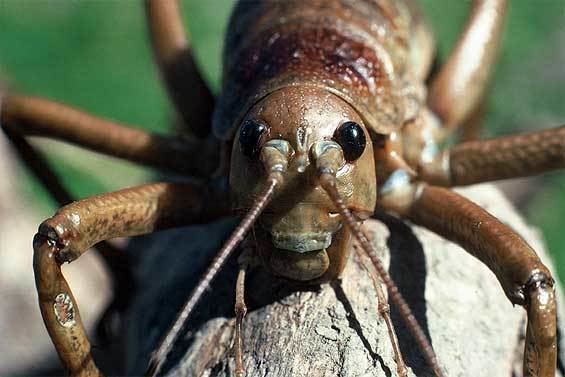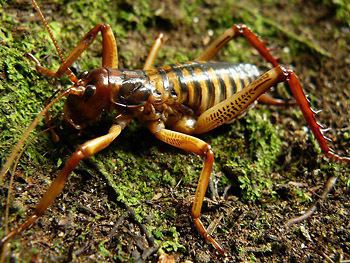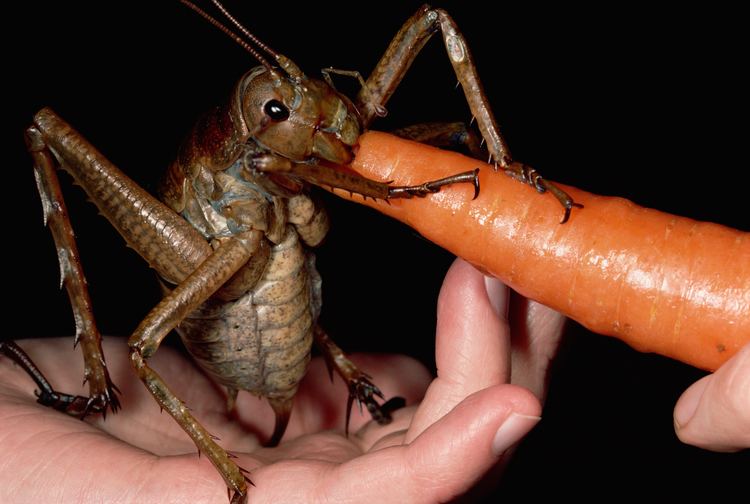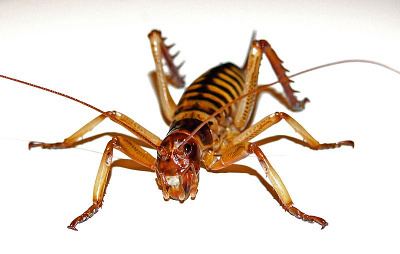Kingdom Animalia Class Insecta Suborder Ensifera | Phylum Arthropoda Order Orthoptera | |
 | ||
Superfamily Stenopelmatoidea,Rhaphidophoroidea Representative species Tree weta, Northland tusked weta, Parktown prawn, Deinacrida heteracantha, Diestrammena asynamora | ||
Absurd creatures meet the weta an insect as big as a gerbil
Weta (plural weta) is the common name for a group of about 70 insect species in the families Anostostomatidae and Rhaphidophoridae, endemic to New Zealand. The word is from the Māori language, where singular and plural have the same form.
Contents
- Absurd creatures meet the weta an insect as big as a gerbil
- Saving New Zealands prehistoric giant weta earthrise
- General characteristics
- Taxonomy and evolution
- Species
- Giant weta
- Tree weta
- Tusked weta
- Ground weta
- Cave weta
- Conservation
- In popular culture
- References

Saving New Zealand's prehistoric giant weta - earthrise
General characteristics

Many weta are large by insect standards and some species are among the largest and heaviest in the world. Their physical appearance is like a katydid, long-horned grasshopper, or cricket, but the hind legs are enlarged and usually very spiny. Many are wingless. Because they can cope with variations in temperature, weta are found in a variety of environments, including alpine, forests, grasslands, caves, shrub lands and urban gardens. They are nocturnal, and all New Zealand species are flightless. Different species have different diets. Most weta are predators or omnivores preying on other invertebrates, but the tree and giant weta eat mostly lichens, leaves, flowers, seed-heads, and fruit.

Weta can bite with powerful mandibles. Tree weta bites are painful but not particularly common. Weta can inflict painful scratches, with the potential of infection, but their defence displays consist of looking large and spiky, and they will retreat if given a chance. Tree weta arc their hind legs into the air in warning to foes, and then strike downwards, so the spines could scratch the eyes of a predator. Pegs or ridges at the base of the abdomen are struck by a patch of fine pegs at the base (inner surface) of the legs and this action makes a distinctive sound. These actions are also used in defence of a gallery by competing males. The female weta looks as if she has a stinger, but it is an ovipositor, which enables her to lay eggs inside rotting wood or soil. Some species of Hemiandrus have very short ovipositors, related perhaps to their burrowing into soil and laying their eggs in a special chamber at the end of the burrow.
Taxonomy and evolution

Fossilized orthopterans have been found in Russia, China, South Africa, Australia, and New Zealand, but the relationships are open to different interpretations by scientists. Most weta of both families are found in the Southern Hemisphere. Weta were probably present in ancient Gondwanaland before Zealandia separated from it, although this does not explain their presence in New Zealand. Rhaphidophoridae dispersed over sea to colonize the Chatham Islands. Although they are of an ancient lineage, the present species are quite young, which conflicts with those earlier ideas about dispersal of weta forebears around the Southern Hemisphere (Wallis et al. 2000).

Giant, tree, ground, and tusked weta are all members of the family Anostostomatidae (formerly in the Stenopelmatidae, but recently separated (Johns, 1997)). Cave weta are better called tokoriro, and are members of the family Rhaphidophoridae called cave crickets or camel crickets elsewhere, in a different ensiferan superfamily.
There is another genera in the same superfamily (Stenopelmatoidea) in the southwest of America. These are Jerusalem cricket belonging to the family Stenopelmatidae.
Species
Tree weta eggs are laid over the autumn and winter months and hatch the following spring. A tree weta takes between one and two years to reach adulthood, and over this time will have to shed its skin around ten times as it grows.
Giant weta
The 11 species of giant weta (Deinacrida spp.), most significantly larger than other weta, are themselves large by insect standards. They are heavy insects with a body length of up to 100 mm (3.9 in) excluding their lengthy legs and antennae, and weigh about 20–30 g. A captive giant weta (Deinacrida heteracantha) filled with eggs reached a record 70 g, making it one of the heaviest documented insects in the world and heavier than a sparrow. The largest species of giant weta is the Little Barrier Island weta, also known as the wetapunga. Giant weta tend to be less social and more passive than other weta. They are classified in the genus Deinacrida, which is Greek for "terrible grasshopper". They are found primarily on small islands off the coast of the main islands, and are examples of island gigantism.
Tree weta
Tree weta (Hemideina) are those most commonly encountered in suburban settings in the North Island. They are up to 40 mm long and most commonly live in holes in trees formed by beetle and moth larvae or where rot has set in after a twig has broken off. The hole, called a gallery, is maintained by the weta and any growth of the bark surrounding the opening is chewed away. They readily occupy a preformed gallery in a piece of wood (a weta motel) and can be kept in a suburban garden as pets. A gallery might house a harem of up to 10 juveniles of both sexes, females and one male. Tree weta are nocturnal. Their diet consists of plants and small insects. The males have much larger jaws than the females, though both sexes will hiss and bite when threatened.
The seven species of tree weta are:
Mountain stone weta can survive being frozen for months in a state of suspended animation down to temperatures of about -10 °C. At temperatures below -10 °C approximately 85% of their body water is crystallised, which is one of the highest ice contents known for any animal. During winter their haemolymph (the insect equivalent of blood) contains low molecular weight cryoprotectants such as amino acids especially proline (up to about 100 mM) and the disaccharide trehalose. These substances are synthesized during autumn and their concentration decreases again during spring and summer (Proline concentration decreases to about 10 mM during summer). The amino acids and sugars presumably help to decrease the ice content colligatively. However, they probably also have a direct protective effect on membranes and proteins via direct interaction or by modifying the water layer with the closest proximity to the molecules. It also displays the defensive behaviour of "playing dead", by lying still for a short time on its back with legs splayed and claws exposed and jaws wide open ready to scratch and bite, this behavior is often accompanied with regurgitation.
When the territories of species overlap, as with the related species H. femorata and H. ricta on Banks Peninsula, they may interbreed, although offspring are sterile.
Tusked weta
Tusked weta are characterised by long, curved tusks projecting forward from the male's mandibles. The tusks are used in male-to-male combat, not for biting. Female tusked weta look similar to ground weta. Tusked weta are mainly carnivorous, eating worms and insects. There are three known species in two different subfamilies: the Northland tusked weta Anisoura nicobarica (originally described as a ground weta, Hemiandrus monstrosus), in the subfamily Deinacridinae; the Mercury Islands tusked weta Motuweta isolata; and the most recently discovered, the Raukumara tusked weta Motuweta riparia. Motuweta is in the same subfamily as ground weta, Anostostomatinae.
The Northland tusked weta lives in tree holes, similar to tree weta. The Mercury Islands or Middle Island tusked weta was discovered in 1970. It is a ground-dwelling weta, entombing itself in shallow burrows during the day, and is critically endangered: a Department of Conservation breeding programme has established new colonies on other islands in the Mercury group. The Raukumara tusked weta was discovered in 1996, in the Raukumara Range near the Bay of Plenty. It has the unusual habit of diving into streams and hiding underwater for up to three minutes if threatened. There are probably other tusked weta species still to be discovered.
Ground weta
Ground weta are classified in the genus Hemiandrus. About 40 species of ground weta occur in New Zealand, and several very similar ones are found in Australia. They are also very like the Californian Cnemotettix—a similarity perhaps due to their very similar habits and habitat. Most of the Hemiandrus have not been described. They hide in burrows in the ground during the day, and those that live in open ground (e.g., H. focalis) conceal their exit holes with a specially made perforated door. During the night, ground weta hunt invertebrate prey and eat fruit.
Cave weta
The 60 species of cave weta are only very distant relatives of the other types of weta - being classified in several genera of subfamily Macropathinae in family Rhaphidophoridae.
They have extra-long antennae, and may have long, slender legs and a passive demeanour. Although they have no hearing organs on their front legs like species of Hemideina and Deinacrida, some (e.g., Talitropsis spp.) are very sensitive to ground vibrations sensed through pads on their feet. Specialised hairs on the cerci and organs on the antennae are also sensitive to low-frequency vibrations in the air.
Although some do live in caves, most species live in the forest among leaf litter, logs, tree holes and amongst broken rocks. Cave-dwelling species may be active within the confines of their caves during the daytime, and those individuals close to cave entrances venture outside at night.
Conservation
Although the weta had native predators in the form of birds (especially the weka and kiwi), reptiles, and bats before the arrival of humans, introduced species such as cats, hedgehogs, rats (including kiore) and mustelids have caused a sharp increase in the rate of predation. They are also vulnerable to habitat destruction caused by humans and modification of their habitat caused by introduced browsers. New Zealand's Department of Conservation considers 16 of the 70 species at risk. Programmes to prevent extinctions have been implemented since the 1970s.
Some examples of especially endangered species are tracked by radio beacons.
